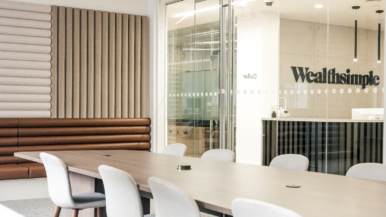This ad agency turned Kenny Hotz’s old house into the perfect post-pandemic office

In early 2020, Fuse Create, an ad agency with 80 employees, had outgrown its longtime Adelaide Street home—not in size, but in spirit. The 14,000-square-foot brick and beam space was very much an old-fashioned office, says CEO Stephen Brown. “Our lease was up in the next year, and our creative team said they’d love something more accessible to the community, instead of feeling locked up in a tower.”
Then came Covid, and the Adelaide office sat mostly empty for 19 months. “By the third month, we knew we could get our work done virtually,” says Brown. The firm leaned hard into fostering a collaborative virtual environment by hosting trivia nights and baking lessons, and sending out care packages. Since everyone already had a laptop, there was minimal disruption on the technical side. Brown started contemplating a permanent hybrid work model, which would mean fewer staff on site at a time—and with it, the option for Fuse to downsize and buy instead of rent.

He wanted something bright, airy and connected to the city’s creative scene. It so happened that a beautiful Ossington Avenue semi—owned by none other than Kenny Hotz of Kenny vs. Spenny—was on the market. Brown describes seeing it as “a whoa moment.”
The three-storey, mixed-use building featured high ceilings, hardwood floors and a flood of natural light. It also had a 1,300-square-foot storefront for pop-up retail and product launches—a major selling point for an ad agency. Another key element: a 630-square-foot rooftop terrace, perfect for events, gatherings or after-work drinks. Fuse bought the building for roughly $3.4 million and started renovating.
A den and bedroom on the second floor became boardrooms; in the third-floor loft space, there’s a large communal table. Each meeting room has a two-way monitor so staff can connect with remote colleagues. There’s also a quiet zone for head-down work, plus BYO-phone soundproof booths for confabs.
At less than a third the size of the Adelaide spot, the new space can accommodate 60 per cent of existing staff. Private offices have been nixed, even for the CEO. All employees use a first-come, first-served system to book space based on their needs.

To reflect the history of the Ossington strip, some original details were preserved, including an old Pepsi sign and a banner from a local Vietnamese restaurant. But there’s no shortage of Fuse-specific finishing touches, like an interior mural and sound-absorption panels decked out in company yellow and blue. And then there’s the ultimate draw come summer: the rooftop’s work cabanas, where indoor-weary creatives can spitball ideas while catching a few rays.














